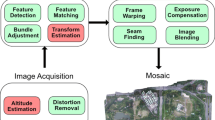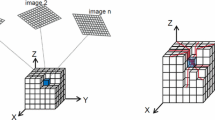Abstract
Matching images of a scene with high precision is a core component in real time applications such as image-based navigation of unmanned aerial vehicles, terminal guidance of missiles. The aim of the research discussed in this paper is to develop a scene matching algorithm of high accuracy, robust to the variations between the images compared with scope for parallelism. After a study of state-of-the-art scene matching algorithms, a local feature-based approach was chosen to meet the stated requirements. The paper discusses the techniques for modules of the algorithm chosen and the methodology implemented after a metric study with a dynamic threshold based nearest neighbour distance ratio matching strategy (DT-NNDR). The metrics and the proposed strategy were tested for the matching of planar images from Affine covariant features group, unmanned aerial vehicle videos from a national defence agency, and satellite images from Google. The performance of strategy was compared with the existing NN-DR strategy with an experimental optimal threshold. The overall precision of the proposed strategy is 88%, making it suitable for applications which require high value of true positive.










Similar content being viewed by others
References
Alberry HA, Hegazy AA, Salama GI (2018). A fast SIFT based method for copy move forgery detection. Future Comput Inform J 3(2):159–165.
Altwaijry H, Veit A, Belongie S (2016) Learning to detect and match keypoints with deep architectures. British Machine Vision Conference 2016, BMVC 2016.
Anderson MJ (2003) Analysis of ecological communities. J Exp Mar Biol Ecol 289:303–305. https://doi.org/10.1016/s0022-0981(03)00091-1
Bay H, Tuytelaars T, Gool LV. (2008) Speeded-up robust features (SURF). Comput Vis Image Underst 110(3):91–110. https://doi.org/10.1016/j.cviu.2007.09.014
Brown LG (2002) A survey of image registration techniques. ACM Comput Surv 24(4):325–376
Cai GR, Jodoin PM, Li SZ, Wu YD, Su SZ, Huang ZK (2013) Perspective-SIFT: an efficient tool for low-altitude remote sensing image registration. Signal Process 93(11):3088–3110. https://doi.org/10.1016/j.sigpro.2013.04.008
Cardozo De Souza Ribeiro PO, MacHado Dos Santos M, Lilles Jorge Drews P, Silva Da Costa Botelho S (2017) Forward looking sonar scene matching using deep learning. Proceedings - 16th IEEE International Conference on Machine Learning and Applications, ICMLA 2017
Cha S-H (2007) Comprehensive survey on distance/similarity measures between probability density functions. Int J Math Model Meth Appl Sci 1
Deza MM, Deza E (2009) Encyclopedia of distances. Encyclopedia Distances. https://doi.org/10.1007/978-3-642-00234-2
Dosovitskiy A, Fischer P, Springenberg JT, Riedmiller M, Brox T (2016) Discriminative unsupervised feature learning with exemplar convolutional neural networks. IEEE Trans Pattern Anal Mach Intell 38:1734–1747
Dou J, Qin Q, Tu Z (2018) Robust image matching based on the information of SIFT. Optik 171:850–861. https://doi.org/10.1016/j.ijleo.2018.06.094
Dusmanu M, Rocco I, Pajdla T, Pollefeys M, Sivic J, Torii A, Sattler T (2019) D2-net: a trainable CNN for joint description and detection of local features. Proc IEEE Comput Soc Conf Comput Vision Pattern Recog. https://doi.org/10.1109/CVPR.2019.00828
Evans C (2009) Notes on the OpenSURF library, University of Bristol
Faith DP, Minchin PR, Belbin L (1987) Compositional dissimilarity as a robust measure of ecological distance. Vegetatio 69:57–68. https://doi.org/10.1007/BF00038687
Ferreira C (2001) Gene expression programming: a new adaptive algorithm for solving problems. Complex Systems, 13(2), 1–22. Retrieved from http://arxiv.org/abs/cs/0102027
Gavin DG, Oswald WW, Wahl ER, Williams JW (2003) A statistical approach to evaluating distance metrics and analog assignments for pollen records. Quat Res 60:356–367. https://doi.org/10.1016/S0033-5894(03)00088-7
Goshtasby AA (2005) 2-D and 3-D image registration: for medical, remote sensing, and industrial applications. Wiley-Interscience
Hartley R, Zisserman A (2004) Multiple view geometry in computer vision. Cambridge University Press, New York, p 673
Huang C, Zhou W (2014) A real-time image matching algorithm for integrated navigation system. Optik 125(16):4434–4436
Jiang J, Cao S, Zhang G, Yuan Y (2013) Shape registration for remote-sensing images with background variation. Int J Remote Sens 34:5265–5281. https://doi.org/10.1080/01431161.2013.786195
Kannan K, Kanna BR, Aravindan C (2010) Root mean square filter for noisy images based on hyper graph model. Image Vis Comput 28:1329–1338. https://doi.org/10.1016/j.imavis.2010.01.013
Kokare M, Chatterji BN, Biswas PK (2003) Comparison of similarity metrics for texture image retrieval. IEEE region 10 annual international conference, proceedings/TENCON. https://doi.org/10.1109/tencon.2003.1273228
Lindeberg T (1993) Scale-space theory in computer vision. Kluwer Academic Publishers, Norwell
Lowe DG (2004) Distinctive image features from scale-invariant keypoints. Int J Comput Vis 60(2):91–110. https://doi.org/10.1023/B:VISI.0000029664.99615.94
Lyu C, Jiang J (2017) Remote sensing image registration with line segments and their intersections. Remote Sens 9(5). https://doi.org/10.3390/rs9050439
Manjunath BS (1996) Texture features for browsing and retrieval of image data. IEEE Trans Pattern Anal Mach Intell 18:837–842. https://doi.org/10.1109/34.531803
Mikolajczyk K, Schmid C (2005) A performance evaluation of local descriptors. IEEE Trans Pattern Anal Mach Intell 27(10):1615–1630. https://doi.org/10.1109/TPAMI.2005.188
Moisan L, Moulon P, Monasse P (2012) Automatic homographic registration of a pair of images, with a Contrario elimination of outliers. Image Processing On Line 2(2012):56–73. https://doi.org/10.5201/ipol.2012.mmm-oh
Mount DM, Netanyahu NS, Moigne JL (1999) Efficient algorithms for robust feature matching. Pattern Recogn 32:17–38. https://doi.org/10.1016/S0031-3203(98)00086-7
Pele O, Werman M (2008) A linear time histogram metric for improved SIFT matching. Lecture notes in computer science (including subseries lecture notes in artificial intelligence and lecture notes in bioinformatics)
Pele O, Werman M (2010) The quadratic-chi histogram distance family. Lecture Notes in Computer Science (Including Subseries Lecture Notes in Artificial Intelligence and Lecture Notes in Bioinformatics)
Rabin J, Delon J, Gousseau Y (2008) A contrario matching of SIFT-like descriptors. Proc- Int Conf Pattern Recog. https://doi.org/10.1109/icpr.2008.4761371
Raguram R, Frahm JM, Pollefeys M (2008) A comparative analysis of RANSAC techniques leading to adaptive real-time random sample consensus. In: Computer Vision – ECCV 2008, Lecture notes in computer science (including subseries lecture notes in artificial intelligence and lecture notes in bioinformatics), vol 5303. Springer, Berlin Verlag
Soni B, Das PK, Thounaojam DM (2019) Geometric transformation invariant block based copy-move forgery detection using fast and efficient hybrid local features. J Inform Secur Appl 45:44–51
Tuytelaars T, Mikolajczyk K (2007) Local invariant feature detectors: a survey. Found Trends® Comput Graphics Vision 3(3):177–280. https://doi.org/10.1561/0600000017
Vadivel A, Majumdar AK, Sural S (2003) Performance comparison of distance metrics in content-based image retrieval applications. Proc. of Internat. Conf. on Information Technology, Bhubaneswar, pp 159–164
Wang X, Fu W (2008) Optimized SIFT image matching algorithm. Proceedings of the IEEE international conference on automation and logistics, ICAL 2008, September, pp. 843–847. https://doi.org/10.1109/ICAL.2008.4636267
Wang M, Song T (2012) By scene semantic matching. IEEE Trans Geosci Remote Sens 51(5):1–13
Xiang L (2013) Scene matching techniques: modeling and analysis. In: Yang Y, Ma M, Liu B (eds) Information computing and applications. ICICA 2013. Communications in Computer and Information Science, vol 392. Springer, Berlin, pp 184–193
Yahyanejad S, Rinner B (2015) A fast and mobile system for registration of low-altitude visual and thermal aerial images using multiple small-scale UAVs. ISPRS J Photogramm Remote Sens 104:189–202
Yu H, Yang W, Liu Y (2018) Coarse-to-fine accurate registration for airborne Sar images using SAR-FAST and DSP-LATCH. Prog Electromagn Res 163:89–106
Zhang L, Yue X (2015) A method using auxiliary direction to improve SURF recall. Int J Hybrid Inform Technol. https://doi.org/10.14257/ijhit.2015.8.11.04
Zhang H, Wang Y, Luo L, Lu X, Zhang M (2017) SIFT flow for abrupt motion tracking via adaptive samples selection with sparse representation. Neurocomputing 249:253–265
Zhang X, Xiao L, Hu M, Liu J (2019) Scene matching method of video satellite remote sensing image based on deep convolutional neural network. 2019 IEEE 1st international conference on civil aviation safety and information technology (ICCASIT), 211–215. https://doi.org/10.1109/ICCASIT48058.2019.8973200
Acknowledgements
This work was supported by the Council of Scientific and Industrial Research, the premier research and development organization in India, under the Senior Research Fellowship Scheme. (grant number 09/1095/(0009)/2015-EMR-I). The second author wishes to thank Department of Science & Technology –Science and Engineering Research Board for the financial support through FIST No.: SR/FST/MSI-107/2015 and TATA Realty IT city-SASTRA Srinivasan Ramanujan Research Cell.
Author information
Authors and Affiliations
Corresponding author
Additional information
Publisher’s note
Springer Nature remains neutral with regard to jurisdictional claims in published maps and institutional affiliations.
Appendix
Appendix
The theoretical justification derived for the higher performance city block compared to the Chessboard and Euclidean, with the NN-DR strategy, is as follows:
Figure 11 shows the geometrical representation of the distances between two descriptors A (d1, d2) and C (d1’, d2’) in a 2D plane. From the figure with triangle ABC, we can observe line AB stands for the difference in the first dimension |d1-d1’|, and BC is the difference in the second dimension |d2-d2’|.
By properties of the triangle
The determination of the corresponding feature for a feature p from the feature set Q can be mathematically expressed as follows:
Here q1 and q2 are the first and second nearest neighbours of p from Q respectively.
Using Eq. (10)
Negating Eq. (13),
Since opposite inequalities can be added, Eqs. (13) and (14) can be combined as,
We can observe from Eq. (15) that the difference between the first minimum and second minimum distances is the highest for the city block followed by Euclidean and Chessboard metrics.
Higher the difference between the numerator and the denominator, lesser will be the value of the fraction. Hence from (15),
From Eq. (16), it can be observed that the ratio between the first minimum and the second minimum is the least for the city block distance metric. Hence more cases will satisfy the condition in Eq. (11) for feature correspondence, resulting in more matches by city block distance metric than the widely used Euclidean and Chessboard with the NN-DR matching strategy.
Rights and permissions
About this article
Cite this article
Krishnan, D.L., Kannan K, Muthaiah R et al. Evaluation of metrics and a dynamic thresholding strategy for high precision single sensor scene matching applications. Multimed Tools Appl 80, 18803–18820 (2021). https://doi.org/10.1007/s11042-021-10656-y
Received:
Revised:
Accepted:
Published:
Issue Date:
DOI: https://doi.org/10.1007/s11042-021-10656-y





